Nice subject matter and good visibility is a prerequisite for a great image. But just as important is correct lighting.
Contributed by
Daylight is a constant light source that influences the film or the CCD-sensor in a digital camera as long as the shutter is open. This creates a photographic rule; the longer the shutter remains open with the same aperture, the brighter the image will be. Another aspect in daylight photography is the speed of the subject. To catch the image of a rapid swimming pilot whale, you should not go below 1/250 second. If you do, your image will be blurred.
Strobes, on the other hand, release their flash in a fraction of a second and are always faster than the shutter. Hence, fast moving subjects are no problem for strobes, as the light emitted will “freeze” the subject in the image.
Exposure techniques
The most ideal subjects are sea mammals that swim near the surface. The best way to catch images of these animals is by snorkeling—in this way, a strobe is redundant. Additionally, images captured without a strobe are clearer than with one.
Even in the clearest water, you will always find particles that will reflect the strobe light. Also in wreck and landscape photography, you can often skip the strobe if the distances to the subject are not too great. Images don’t get more expressive (color rich) under water, because the red color disappears already at three meters distance anyway.
Image techniques for under water daylight images are no different from those used above the surface. But ideally, an underwater photographer should only work with two kinds of exposure techniques: manual or shutter priority. These are the only ways which allow you to adjust the shutter speed according to the movement of the subject.
( ... )



























